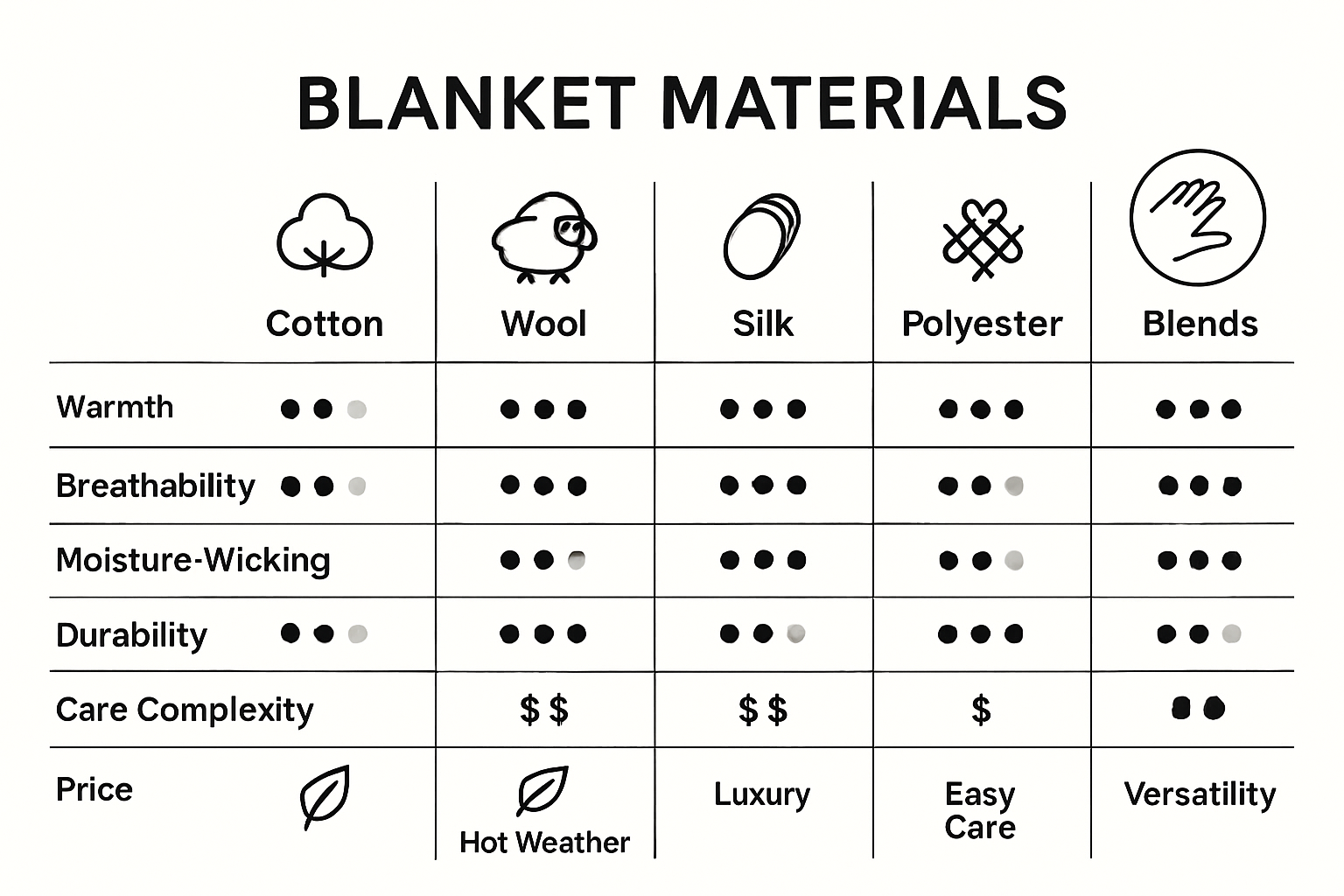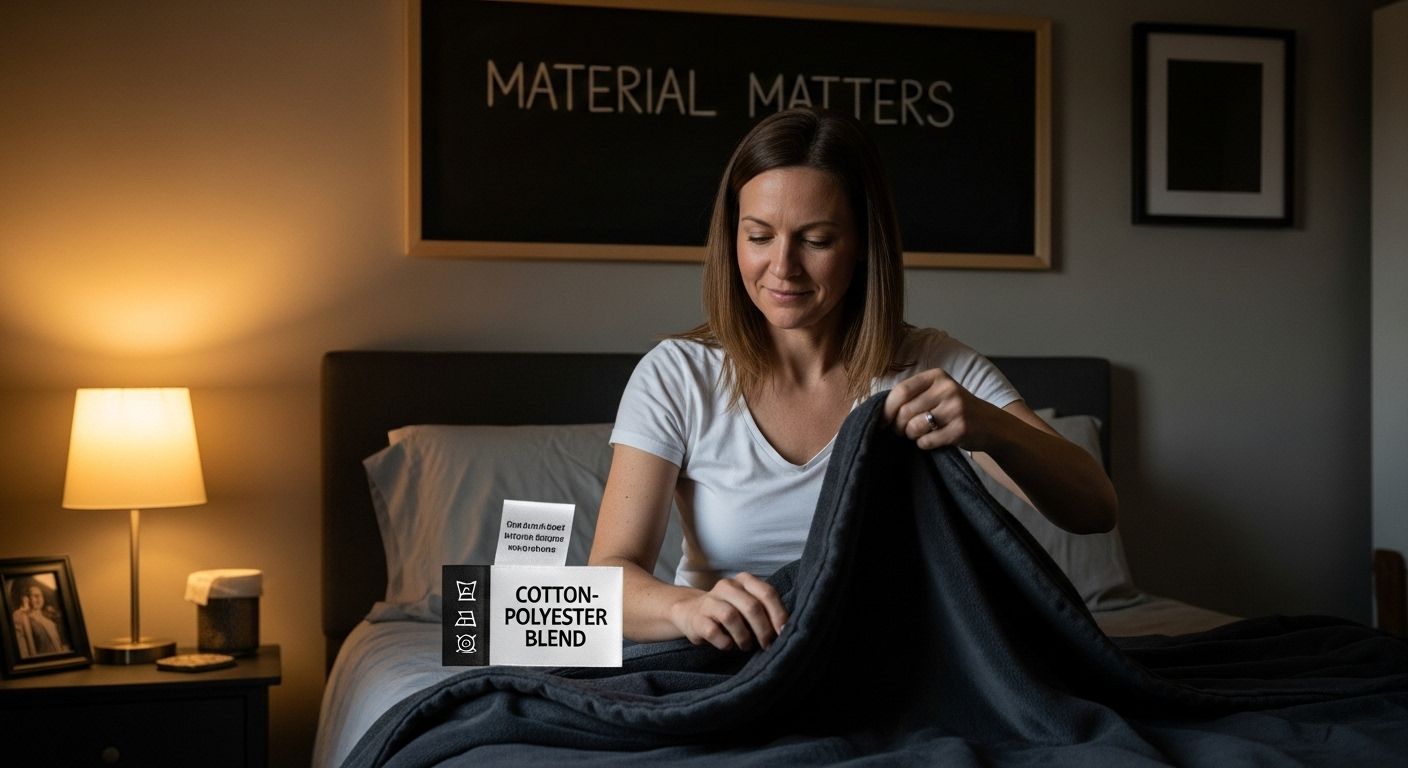Understanding the Best Materials for Blankets

Picking the best material for a blanket might seem simple at first. Then you realize that some fibers can actually improve sleep quality and help regulate your body temperature more than others. The surprise is most people ignore these differences and end up missing out on the true comfort and long-term value a smart blanket choice can deliver.
Table of Contents
- What Are The Best Materials For Blankets And Their Benefits?
- Why Choosing The Right Material For Your Blanket Matters
- How Different Fabrics Affect Warmth And Comfort
- Key Characteristics Of Popular Blanket Materials
- Real-World Applications And Trends In Blanket Fabrics
Quick Summary
| Takeaway | Explanation |
|---|---|
| Choose natural fibers for comfort | Natural fibers like cotton, wool, and silk offer breathability, softness, and superior thermal regulation, enhancing overall user experience. |
| Consider your climate and lifestyle | Select materials based on your environment and personal comfort needs; colder climates may require wool, while warmer areas may benefit from cotton. |
| Understand moisture management | Fabrics like wool wick moisture away, enhancing comfort and preventing overheating, making them ideal for varying temperatures. |
| Invest in quality for durability | High-quality natural materials may have a higher initial cost but provide long-term comfort and durability, making them a smart investment. |
| Explore hybrid materials for versatility | Blends of natural and synthetic fibers combine the best characteristics, offering comfort and durability suitable for diverse preferences and applications. |
What Are the Best Materials for Blankets and Their Benefits?
Choosing the right blanket material transforms your comfort experience from ordinary to extraordinary. Different materials offer unique qualities that impact warmth, softness, durability, and overall user satisfaction.
Natural Fiber Champions
Natural fibers remain the gold standard for blanket materials, offering exceptional breathability and comfort. According to research published in the International Journal of Environmental Research and Public Health, specific textile fibers significantly influence sleep quality and thermal regulation.
Top Natural Blanket Materials:
- Cotton: Lightweight, breathable, and perfect for year-round use
- Wool: Exceptional thermal regulation and moisture-wicking properties
- Silk: Luxuriously smooth and temperature-adaptive
Each natural fiber brings distinct advantages. Cotton provides excellent air circulation, preventing overheating during warmer nights. Wool creates incredible insulation, trapping body heat while allowing moisture to escape. Silk offers unparalleled softness and temperature control, making it ideal for sensitive skin.
Synthetic Material Innovations
Modern synthetic materials have revolutionized blanket technology, offering enhanced performance characteristics. Polyester and microfiber blankets provide incredible durability, easy maintenance, and consistent warmth without the higher costs associated with natural fibers.
Key Synthetic Blanket Advantages:
- Lightweight and quick-drying
- Resistant to wrinkles and shrinkage
- More affordable than premium natural materials
- Enhanced color retention and pattern durability
Synthetic blends combine the best attributes of different materials, creating versatile blankets suitable for various environments and personal preferences. By understanding material properties, consumers can select blankets that perfectly match their comfort, style, and functional requirements.
Why Choosing the Right Material for Your Blanket Matters
Blankets are more than just fabric—they represent comfort, warmth, and personal style. Understanding how different materials impact your overall experience is crucial for making an informed purchase.
The Science of Comfort
Blanket materials directly influence thermal regulation, moisture management, and personal comfort. According to research from New Mexico State University, fabric selection impacts durability, maintenance, and user experience.
Critical Material Performance Factors:
- Thermal insulation capabilities
- Moisture-wicking properties
- Skin sensitivity considerations
- Long-term durability and maintenance
Consumers often overlook the nuanced differences between materials. A wool blanket provides exceptional warmth but might feel scratchy, while cotton offers softness but less insulation. Understanding these subtle distinctions helps select the perfect blanket for specific needs.
Personal Comfort and Lifestyle Alignment
Your blanket material should reflect your lifestyle and personal preferences. Individuals with sensitive skin might prefer smooth silk or soft cotton, while those living in colder regions might prioritize wool’s superior heat retention. Climate, personal temperature preferences, and intended use all play significant roles in material selection.
Beyond comfort, consider how different materials complement your home aesthetic. For those interested in personalized home decor, explore our custom woven blanket collection that combines material quality with personalized design.
Long-Term Investment Considerations
Choosing the right blanket material is essentially a long-term investment in comfort. High-quality materials might have higher upfront costs but provide better durability, maintaining performance and appearance over years of use. Synthetic blends offer affordability, while natural fibers promise premium experiences.
By understanding material characteristics, you transform a simple blanket purchase into a thoughtful decision that enhances daily comfort and reflects personal style.
How Different Fabrics Affect Warmth and Comfort
Fabric selection is a sophisticated science that goes beyond simple aesthetic choices. Understanding how different materials interact with body temperature and personal comfort can transform your blanket experience from ordinary to extraordinary.
Thermal Resistance and Body Heat Regulation
According to research in the International Journal of Biometeorology, textile properties profoundly impact human thermal comfort. Different fabrics possess unique thermal resistance capabilities that directly influence warmth retention and body temperature management.
Key Thermal Performance Characteristics:
- Ability to trap air between fabric fibers
- Rate of heat transfer from body to environment
- Moisture-wicking and evaporation properties
- Insulation efficiency under varying temperatures
Wool, for instance, creates microscopic air pockets that retain heat exceptionally well. Cotton allows more air circulation, making it ideal for moderate temperatures. Synthetic materials like polyester can be engineered to provide targeted thermal regulation.
Moisture Management and Comfort
Beyond temperature, fabric performance depends on moisture management. Breathable materials prevent overheating and excessive sweating, ensuring consistent comfort. Natural fibers like merino wool excel at moisture transportation, pulling perspiration away from skin and enabling rapid evaporation.
Synthetic fabrics often incorporate advanced moisture-wicking technologies, creating lightweight blankets that adapt quickly to body temperature changes. Check out our personalized blanket designs that combine cutting-edge fabric technology with personalized style.
Psychological Comfort and Sensory Experience
Comfort isn’t just physical—it’s also psychological. Fabric texture, weight, and softness contribute significantly to perceived warmth and emotional satisfaction. A soft, lightweight blanket can feel warmer than a heavy, rough material, demonstrating that comfort is a complex, multisensory experience.
Understanding these nuanced interactions between fabric, body, and environment empowers consumers to make informed choices that enhance personal comfort and well-being.
Key Characteristics of Popular Blanket Materials
Blanket materials are not created equal. Each fabric brings unique properties that dramatically influence comfort, durability, and overall user experience. Understanding these nuanced characteristics helps consumers make informed purchasing decisions.
To help you compare at a glance, here are the main characteristics of the most popular blanket materials discussed in this guide:
| Material | Breathability | Thermal Regulation | Moisture Management | Notable Benefits |
|---|---|---|---|---|
| Cotton | Excellent | Moderate | Good | Lightweight, soft, ideal for year-round use |
| Wool | Good | Exceptional | Excellent | Superior warmth, wicks away moisture |
| Silk | Good | Exceptional | Good | Luxurious, good for sensitive skin |
| Polyester | Moderate | Good | Good | Durable, affordable, easy care |
| Microfiber | Good | Good | Good | Soft, lightweight, quick-drying |
| Blends | Varies | Varies | Varies | Combines traits for balance of comfort/durability |

Natural Fiber Performance
According to research from Simoo Sourcing, natural fibers offer distinct advantages in blanket manufacturing. These materials bring inherent qualities that synthetic alternatives struggle to replicate.
Natural Fiber Highlights:
- Exceptional breathability
- Superior moisture management
- Temperature-regulating capabilities
- Biodegradable and environmentally friendly
Cotton provides lightweight comfort with excellent air circulation. Wool delivers extraordinary thermal insulation, creating warmth even in cold environments. Silk offers luxurious softness with remarkable temperature adaptability, making it perfect for sensitive skin.
Synthetic Material Engineering
Synthetic materials represent technological innovation in textile design. Polyester and microfiber blankets are engineered to provide specific performance characteristics, addressing limitations found in natural fibers.
Synthetic Material Advantages:
- Consistent performance across temperatures
- Enhanced durability
- Simplified maintenance
- More affordable production costs
These engineered fabrics can be designed with precise thermal properties, moisture-wicking capabilities, and resistance to wear. For those seeking personalized comfort, explore our custom woven blanket designs that combine advanced material science with individual style.
Hybrid and Blended Materials
Modern blanket technology increasingly focuses on hybrid materials that combine the best attributes of natural and synthetic fibers. Cotton-polyester blends offer improved durability while maintaining breathability. Wool-synthetic combinations provide enhanced insulation with reduced maintenance complexity.
By understanding these material characteristics, consumers can select blankets that perfectly balance performance, comfort, and personal aesthetic preferences.

Real-World Applications and Trends in Blanket Fabrics
Blanket fabrics have evolved far beyond simple warmth provision, becoming sophisticated tools for comfort, health, and personal expression. Modern textile innovations are transforming how we perceive and utilize blankets across various environments.
Healthcare and Therapeutic Applications
According to recent medical research, blanket materials play a critical role in patient care and therapeutic settings. Healthcare professionals now recognize fabric selection as a crucial element in treatment and recovery processes.
Emerging Healthcare Blanket Trends:
- Hypoallergenic fabric development
- Antimicrobial textile treatments
- Temperature-regulating materials
- Pressure-reducing fabrics for patient comfort
Specialized blankets with embedded thermal sensors can monitor patient temperature, while moisture-wicking materials help prevent bacterial growth. These advancements demonstrate how blanket technology has transcended traditional comfort boundaries.
Environmental and Sustainability Considerations
Consumers are increasingly demanding eco-friendly blanket materials that minimize environmental impact. Recycled polyester, organic cotton, and bamboo fabrics represent growing trends in sustainable textile production.
Sustainable Fabric Characteristics:
- Reduced carbon footprint
- Minimal chemical processing
- Renewable resource utilization
- Enhanced biodegradability
Manufacturers are investing in circular economy principles, creating blankets that can be recycled or composted. Explore our commitment to personalized, sustainable design that balances individual style with environmental responsibility.
Performance and Lifestyle Integration
Modern blankets are no longer passive accessories but active lifestyle companions. Smart textiles with temperature-adaptive properties, moisture management, and lightweight construction are gaining popularity among active individuals and outdoor enthusiasts.
From professional athletes seeking optimal recovery to remote workers designing comfortable home environments, blanket fabrics now represent a sophisticated intersection of technology, comfort, and personal expression.
Bring Home Comfort and Character with the Best Blankets
You have just learned how different fabrics can shape warmth, breathability, and comfort for your unique needs. Maybe you are searching for a blanket that combines luxurious materials with a special connection to your life or loved ones. Settling for generic designs means missing out on the dual benefits of premium comfort and meaningful personalization.
Discover how our Personalized Monogram Throw Blanket collection lets you choose from finely crafted fabrics while adding initials or meaningful details that turn every blanket into a cherished piece. Experience the difference of American craftsmanship and the stories woven into each custom design, made just for you.

Ready to elevate comfort with style and heart? Explore your options at FunLifeNow today for thoughtful gifts and personalized home accents. Act now and let your new favorite blanket be a daily reminder of what matters most.
Frequently Asked Questions
What are the benefits of using natural fiber blankets?
Natural fiber blankets, such as cotton, wool, and silk, offer exceptional breathability, moisture management, and temperature regulation, enhancing overall comfort.
How do synthetic blankets compare to natural fiber blankets?
Synthetic blankets, like polyester and microfiber, are generally more durable, wrinkle-resistant, and affordable. They often provide consistent warmth and require less maintenance compared to natural fibers.
What factors should I consider when choosing a blanket material?
When choosing a blanket material, consider thermal insulation, moisture-wicking properties, skin sensitivity, and how the material aligns with your personal comfort and lifestyle needs.
How do different materials affect warmth and comfort in blankets?
Different materials have unique thermal resistance capabilities and moisture management features. For instance, wool retains heat well, while cotton offers better air circulation, making them suitable for varying climates and preferences.
Recommended
- Personalized South Dakota State Woven Blanket – Custom Home Gift for C – FunLifeNow
- Personalized South Dakota State Woven Blanket – Custom Home Gift for C – FunLifeNow
- Personalized Wisconsin State Woven Blanket – Custom Home Throw for Cou – FunLifeNow
- Personalized Wisconsin State Woven Blanket – Custom Home Throw for Cou – FunLifeNow
